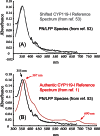Reactive intermediates in cytochrome p450 catalysis
- PMID: 23632017
- PMCID: PMC3682513
- DOI: 10.1074/jbc.R113.473108
Reactive intermediates in cytochrome p450 catalysis
Abstract
Recently, we reported the spectroscopic and kinetic characterizations of cytochrome P450 compound I in CYP119A1, effectively closing the catalytic cycle of cytochrome P450-mediated hydroxylations. In this minireview, we focus on the developments that made this breakthrough possible. We examine the importance of enzyme purification in the quest for reactive intermediates and report the preparation of compound I in a second P450 (P450ST). In an effort to bring clarity to the field, we also examine the validity of controversial reports claiming the production of P450 compound I through the use of peroxynitrite and laser flash photolysis.
Keywords: Cytochrome P450; Enzyme Catalysis; Enzyme Purification; Heme; P450 Compound I; Spectroscopy.
Figures




Similar articles
-
Spectra and kinetic studies of the compound I derivative of cytochrome P450 119.J Am Chem Soc. 2008 Oct 8;130(40):13310-20. doi: 10.1021/ja802652b. Epub 2008 Sep 13. J Am Chem Soc. 2008. PMID: 18788736 Free PMC article.
-
Oxidizing intermediates in P450 catalysis: a case for multiple oxidants.Adv Exp Med Biol. 2015;851:63-81. doi: 10.1007/978-3-319-16009-2_2. Adv Exp Med Biol. 2015. PMID: 26002731 Review.
-
Cytochrome p450 compound I.J Am Chem Soc. 2006 Apr 12;128(14):4580-1. doi: 10.1021/ja060048y. J Am Chem Soc. 2006. PMID: 16594688 Free PMC article.
-
Kinetics of oxidation of benzphetamine by compounds I of cytochrome P450 2B4 and its mutants.J Am Chem Soc. 2009 Mar 4;131(8):2971-6. doi: 10.1021/ja808982g. J Am Chem Soc. 2009. PMID: 19209859 Free PMC article.
-
Spectroscopic studies of the cytochrome P450 reaction mechanisms.Biochim Biophys Acta Proteins Proteom. 2018 Jan;1866(1):178-204. doi: 10.1016/j.bbapap.2017.06.021. Epub 2017 Jun 28. Biochim Biophys Acta Proteins Proteom. 2018. PMID: 28668640 Free PMC article. Review.
Cited by
-
Living with Oxygen.Acc Chem Res. 2018 Aug 21;51(8):1850-1857. doi: 10.1021/acs.accounts.8b00245. Epub 2018 Jul 17. Acc Chem Res. 2018. PMID: 30016077 Free PMC article.
-
Novel insights into oxidation of fatty acids and fatty alcohols by cytochrome P450 monooxygenase CYP4B1.Arch Biochem Biophys. 2020 Jan 15;679:108216. doi: 10.1016/j.abb.2019.108216. Epub 2019 Dec 1. Arch Biochem Biophys. 2020. PMID: 31801692 Free PMC article.
-
Lifting iron higher and higher.Nat Chem. 2024 Apr;16(4):481-482. doi: 10.1038/s41557-024-01484-2. Nat Chem. 2024. PMID: 38548885 No abstract available.
-
Mechanisms of superoxide signaling in epigenetic processes: relation to aging and cancer.Aging Dis. 2015 Jun 1;6(3):216-27. doi: 10.14336/AD.2014.0924. eCollection 2015 Jun. Aging Dis. 2015. PMID: 26029480 Free PMC article. Review.
-
Methane-Oxidizing Enzymes: An Upstream Problem in Biological Gas-to-Liquids Conversion.J Am Chem Soc. 2016 Aug 3;138(30):9327-40. doi: 10.1021/jacs.6b04568. Epub 2016 Jul 19. J Am Chem Soc. 2016. PMID: 27366961 Free PMC article. Review.
References
-
- Rittle J., Green M. T. (2010) Cytochrome P450 compound I: capture, characterization, and C–H bond activation kinetics. Science 330, 933–937 - PubMed
-
- Moss T. H., Ehrenberg A., Bearden A. J. (1969) Mössbauer spectroscopic evidence for electronic configuration of iron in horseradish peroxidase and its peroxide derivatives. Biochemistry 8, 4159–4162 - PubMed
-
- Schonbaum G. R., Lo S. (1972) Interaction of peroxidases with aromatic peracids and alkyl peroxides. Product analysis. J. Biol. Chem. 247, 3353–3360 - PubMed
-
- Jung C. (2011) The mystery of cytochrome P450 compound I: a mini-review dedicated to Klaus Ruckpaul. Biochim. Biophys. Acta 1814, 46–57 - PubMed
Publication types
MeSH terms
Substances
Grants and funding
LinkOut - more resources
Full Text Sources
Other Literature Sources

